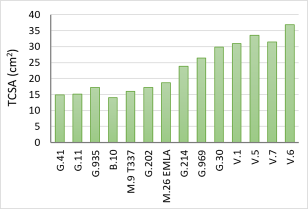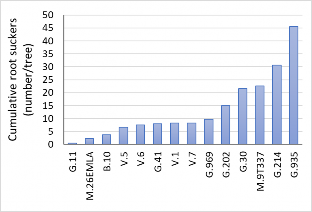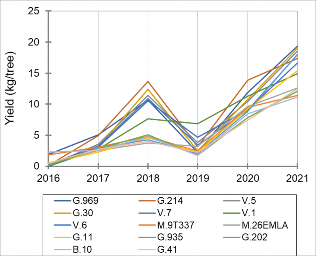Rootstock Effects on Tree Growth and Yield of ‘Honeycrisp’ Apple under Virginia State Climatic Conditions
ID
SPES-398NP
Introduction
Investigating the effects of rootstocks on tree tolerance to biotic and abiotic stresses, tree growth, vigor, yield, and fruit quality helps tree fruit growers make informed decisions about the planting densities, production systems, and marketing schemes that suit their needs. Most of the known apple rootstocks were initially generated through breeding programs to provide particular attributes (e.g. resistance to fire blight, cold-hardiness and low vigor) to the grafted scion varieties. However, the production efficiency of any rootstock-scion combination can be influenced by factors other than the genetic makeup of the rootstock. These factors include, but are not limited to, soil type, weather conditions during dormant and growing seasons, and disease load that could differ among states and countries. Therefore, this publication is intended to show the performance of 'Honeycrisp' apple trees on 14 size-controlling rootstocks under Virginia State climatic conditions after seven years of planting.
The rootstocks examined in this trial were developed by different North American and European breeding programs. The Malling rootstocks, generally referred to as M., e.g., M.9 and M.26, were developed at the East Malling Research Station, Kent, England. These rootstocks are widely planted in the US. M.9 is used globally as the standard for dwarf rootstocks and is known for its precocity, high-yield efficiency, and resistance to crown and root rots (Marini and Fazio, 2018). However, M.9 is also notorious for being highly susceptible to fire blight, wooly apple aphid, and the apple replants disease. M.26 resulted from a cross between M.9 and M.16 and is not as dwarfing as M.9, but it is precious and highly productive. Like M.9, M.26 is highly susceptible to fire blight and wooly apple aphid. It has also been reported that M.26 forms weak graft unions with ‘Honeycrisp’. (Cline and Gardner, 2005). The Geneva series of rootstocks, referred to as G., e.g., G.935 and G.11, were developed by the Geneva Apple Rootstock Breeding Program, a joint venture between Cornell University and the United States Department of Agriculture (USDA). These rootstocks provide a wide range of vigor, with some producing the same tree size as M.9 (e.g., G.11 and G.41) and M.26 (e.g., G.935 and G.202). All the G. rootstocks are reported to be resistant to fire blight, tolerant to Phytophthora root and crown rot, less prone to developing rootsuckers and burrknots, and are winter hardy. Some G. rootstocks, e.g., G.214 and G.41, also show high resistance to wooly apple aphid and the replant disease complex (Fazio, 2018). Budagovsky rootstocks, referred to as Bud or B. (e.g., B.9 and B.10), were developed in the Soviet Union by crossing M.8 x Red Standard (Krasnij Standart). B.10 was developed at the Michurinsk University of Agriculture, Russia, from crossing B.9 X B.13-14. The rootstock produces a tree similar in size and production to M.9 T337. Vineland series of rootstocks, referred to as V. (e.g., V.1 and V.6), were developed at the Horticultural Experiment Station at Vineland, Ontario, from open-pollinated hybrids of ‘Kerr’ crabapples and M.9 rootstock. Reports on these rootstocks indicate that V.1, V.5, V.6, and V.7 are considered dwarfing to semi-dwarfing rootstocks (Cline et al., 2001, Autio et al., 2005).
Plant Material and Trial Characteristics:
'Honeycrisp' scions grafted on 14 dwarfing and semi-dwarfing rootstocks (B.10, G.11, G.202, G.214, G.30, G.41, G.935, G.969, M.26 EMLA, M.9 T337, V.1, V.5, V.6, V.7) were planted in a commercial orchard (Saunders Brothers Orchard, Piney River) in Central Virginia in 2014 as a part of an NC-140 project that encompasses nine states. The purpose of this multi-state project was to evaluate the effects of different dwarfing and semi-dwarfing rootstocks on the tree and crop characteristics (e.g. trunk cross sectional area (TCSA), number of rootsuckers, and yield (kg/tree)) of 'Honeycrisp' apples. Trees were spaced at 4 ft within row and 12 ft between rows (907 tree/acre), and trained to a tall-spindle training system. Trees were arranged in the field according to a completely randomized design (CRD) with ten single-tree replicates. Trunk circumference (cm), 1 ft above the graft union, was measured each fall, and used to calculate TCSA. Cumulative root suckers were calculated as the total number of suckers a rootstock produced during six years (2016-2021). The cumulative yield was calculated as the sum of yields from 2016-2021. The cumulative yield efficiency (kg/TCSA) was calculated by dividing the cumulative yield, by the TCSA of the final year of this trial (2021). Trees were fertilized and managed for pests and diseases according to the Spray Bulletin for Commercial Tree Fruit Growers, VCE Publication 456-419.

Trial Results & Discussion
Tree vigor: Among the 14 rootstocks investigated in this trial, V-series and G.30 produced the most vigorous trees, with TCSA values ranging between 27.6 - 36.5 cm2; whereas G.41, G.11, G.935, B.10, M.9, and M.26 produced the most dwarfing trees with TCSA values ranging between 13.2 to 17.6 cm2. G.214 and G.969 produced medium-sized trees with a TCSA of 23.3 – 24.5 cm2, respectively.
The TCSA data collected in 2021, seven years after planting, showed that trees on G.41, G.11. G.202, and G.935 were similar in size to those on M.9 (Table 1); which is consistent with previous reports that placed these rootstocks under the “dwarfing” category (Autio et al., 2020). The TCSA values recorded during seven years (2015-2021) consistently showed that these Geneva rootstocks were statistically similar to M.9. B.10 also conferred vigor similar to M.9; however, it was numerically, but not statistically, less dwarfing than M.9, particularly in later years after planting (2019-2021). M.26 and M.9 had statistically similar TCSA values, which was consistent with the findings of the same NC-140 trial in other locations (Cline et al., 2021). G.214, which was previously categorized as a “dwarfing” rootstock most similar to M.9, had TCSA values that were significantly higher than M.9 in most years. Indeed, trees on G.214 were almost 50% larger than those on M.9 and nearly similar in size to G.969, which is generally considered a “semi-dwarfing” rootstock. Similarly, G.30 showed high TCSA values that were 86% and 60% higher than M.9 and M.26, respectively, and should also be placed under the “semi-dwarfing” category. All Vineland rootstocks were significantly more vigorous than M.9 and M.26 and similar to G.30. In fact, trees on V. rootstocks were twice the size of trees on M.9 (Table 1), making them unsuitable for high-density planting systems under Virginia soil and climatic conditions.
| Rootstocks | Tree vigor relative to M.9 T337 | Tree vigor relative to M.26 EMLA |
|---|---|---|
| G.41 | 0.93 | 0.80 |
| G.11 | 0.94 | 0.81 |
| G.935 | 1.08 | 0.92 |
| B.10 | 0.88 | 0.76 |
| M.9 T337 | 1.00 | 0.86 |
| G.214 | 1.49 | 1.28 |
| G.969 | 1.65 | 1.42 |
| G.30 | 1.87 | 1.60 |
| V.1 | 1.93 | 1.66 |
| V.5 | 2.10 | 1.80 |
| V.7 | 1.96 | 1.69 |
| V.6 | 2.30 | 1.98 |
Incidence of suckering: rootstocks varied significantly in their tendency to produce suckers. For instance, G.935 produced ~ 45 sucker/tree within six years, whereas others such as G.11, B.10 and M.26 produced less than 5 sucker/tree during the same period (Figure 2). The high incidence of suckers is considered a highly undesirable trait, yet the effects of genetics and environment on sucker development are not well understood. In addition to competing with the tree for water and nutrients, suckers are also notorious for serving as infection sites for fire blight and feeding sites for wooly apple aphid.

Cumulative yield: the effects of rootstocks on cumulative yield were highly significant (P= 000.1) (Table 2). The highest six-year cumulative yield (2016-2021) was achieved from 'Honeycrisp' scions on G.214, G.969, and G.30, with averages ranging between 47.9 to 53.1 kg/tree. V. rootstocks also produced high yields, ranging from 43.4 to 47.9 kg/tree. The lowest cumulative yields were harvested from trees on dwarfing rootstocks, e.g., G.41, G.202, B.10, M.9, and M.26, with averages ranging between 29.5 to 32.4 kg/tree. Trees on G.11 and G.935 had higher, but not statistically significant, cumulative yields than those on M.9 and M.26. The annual yield data for the 2017-2019 growing seasons followed the typical biennial nature of ‘Honeycrisp’; however, both 2020 and 2021 seasons were considered as ‘ON’ years. This change in the bearing behavior could be due to the new orchard practices recently adopted in Virginia to improve return bloom, including the multiple applications of NAA products within 45 days after full bloom to induce flower bud formation (Figure 4).

| Rootstocks | Cumulative Yield (kg/tree) (2016-2021) | Cumulative Yield Efficiency (kg/cm2 TCSA) |
|---|---|---|
| G.214 | 53.13 a* | 2.28 a |
| G.969 | 51.08 a | 1.96 abc |
| G.11 | 34.22 bcd | 2.35 a |
| G.935 | 36.26 bcd | 2.30 a |
| G.30 | 47.85 ab | 1.65 abcd |
| B.10 | 30.85 cd | 2.34 a |
| M.9T337 | 32.38 ab | 2.12 ab |
| V.5 | 47.78 ab | 1.47 bcd |
| V.7 | 44.85 abc | 1.47 bcd |
| G.41 | 29.46 d | 1.99 abc |
| M.26EMLA | 32.23 cd | 1.76 abcd |
| V.1 | 43.44 abc | 1.41 cd |
| V.6 | 44.02 abc | 1.22 d |
| G.202 | 29.71 d | 1.78 d |
*Means with the same letter are not significantly different.
References:
Autio, W., Robinson, T., Blatt, S., Cochran, D., Francescato, P., Hoover, E., Kushad, M., et al. 2020. Budagovsky, Geneva, Pillnitz, and Malling apple rootstocks affect ‘Honeycrisp’ performance over eight years in the 2010 NC-140 ‘Honeycrisp’ apple rootstock trial." J. Amer. Pomol. Soc 74, no. 4: 182-195.
Cline, J.A., Autio, W., Clements, J., Cowgill, W., Crassweller, R., Einhorn, T., Fallahi, E., et al. 2021. Early Performance of ‘Honeycrisp’ Apple Trees on Several Size-Controlling Rootstocks in the 2014 NC-140 Rootstock Trial. Journal of the American Pomological Society 75, no. 4: 189-202.
Cline, J.A., Hunter, D.M., Bonn, W.G. and Bijl, M. 2001. Resistance of the Vineland series of apple root-stocks to fire blight caused by Erwinia amylovora." Journal of the American Pomological Society 55, no. 4: 218.
Cline, J.A. and Gardner, J., 2005. Commercial production of Honeycrisp apples in Ontario. Ontario, Ministry of Agriculture, Food and Rural Affairs.
Fazio, G. 2018. Geneva ® apple rootstock comparison chart v.4. 9 Feb 2021. https://ctl.cornell.edu/wp-content/uploads/plants/GENEVA-Apple-Rootstocks-Comparison-Chart.pdf
Marini, R.P. and G. Fazio. 2018. Apple rootstocks: history, physiology, management, and breeding. Hort. Rev. 45:197-312.
Virginia Cooperative Extension materials are available for public use, reprint, or citation without further permission, provided the use includes credit to the author and to Virginia Cooperative Extension, Virginia Tech, and Virginia State University.
Virginia Cooperative Extension is a partnership of Virginia Tech, Virginia State University, the U.S. Department of Agriculture (USDA), and local governments, and is an equal opportunity employer. For the full non-discrimination statement, please visit ext.vt.edu/accessibility.
Publication Date
May 4, 2022



